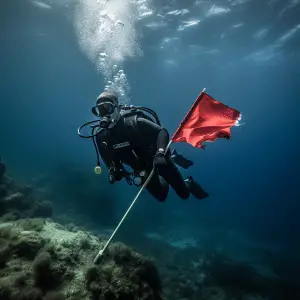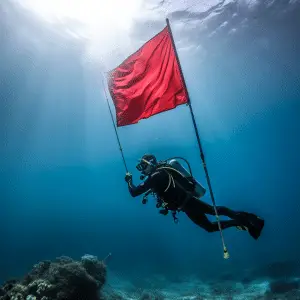Introduction to the Diver Down Flag
The Diver Down Flag is a must for diving safety. It’s red with a white diagonal stripe, and it serves as a warning to passing boats – letting them know that divers are in the water.
This flag prevents accidents, by prompting boats to reduce speed and steer clear of the area. It’s an international symbol, recognized as a standard protocol for underwater safety.
Everyone needs to understand the meaning of this flag. It’s a visual communication tool, conveying the presence of divers and the need for caution.
Next time you see a Diver Down Flag while out on the water, remember its importance. Slow down and steer clear of divers. Doing this contributes to a safer environment and could even save lives! Don’t forget the importance of this flag when navigating near diving areas – it could save you from a shark’s lunch!
Importance of the Diver Down Flag

The Diver Down Flag is a crucial element for a safe dive. It indicates to boaters that there are divers below the surface and that extra caution needs to be taken when navigating the area. This flag is not only about safety, but also shows respect for the diving community and their specific activities.
This flag has an interesting history. In 1956, Denzel James Dockery designed and patented it. He had seen the risks divers faced due to unaware boaters and wanted to decrease accidents and promote unity between them.
So, let’s check out the different Diver Down Flags! Who doesn’t love a flag fashion show before taking the plunge?
Types and variations of Diver Down Flags
Diver Down Flags come in many types and variations. Alpha is red with a white stripe in the middle, Blue and White flags have vertical stripes, Red and White flags have diagonal stripes, and Orange flags are solid. Each flag serves a specific purpose. For example, the Alpha flag is used in areas with motorboats due to its bold color.
Square-shaped flags are also available, providing greater visibility from various angles. When selecting a flag, size matters. Larger flags are more visible from a distance, while smaller flags suit confined spaces. Flags should also be made of durable, weather-resistant materials like nylon or vinyl. Lastly, make sure to secure the flag to a buoy or pole at a proper height for maximum visibility.
These suggestions are important for safety and awareness when diving. Let’s make drowning silently unfashionable!
Regulations and guidelines for displaying Diver Down Flags
Diver Down Flags, also known as SCUBA flags, are vital for safety underwater. They show others that divers are present below the surface. Rules and regulations have been put in place to ensure their effectiveness.
- Size: The flag must be a minimum of 20 inches by 24 inches, so it can be seen from a distance.
- Color: The flag is red with a white diagonal stripe from top left to bottom right.
- Placement: The flag must be clearly visible on an object near the dive site. It should be high enough for other boaters to spot.
- Signals: The flag should be up when divers are underwater. When they’re done, it can be taken down.
Plus, the flag should never be blocked or covered by any other flags. This helps ensure visibility and accuracy.
Tip: If you’re in a group, each member should carry their own flag. This gives extra safety and allows each diver to be identified.
Ready to take the plunge? Just don’t make the mistake of confusing the Diver Down Flag with the ‘Dinner’ Flag – it could be your last meal!
Misconceptions and Challenges of the Diver Down Flag
The Diver Down Flag is oft misconstrued and faces various issues. Let’s explore these misconceptions and the problems linked to this essential safety symbol.
Many folks mistakenly think the Diver Down Flag signals the presence of scuba divers. In truth, it alerts boaters that divers are present in the vicinity.
Some may underestimate its importance, supposing they can ignore it or dash by without care. This can lead to perilous situations for both divers and boaters.
The visibility of the Diver Down Flag can be impaired by environmental factors such as waves, dim lighting, or obstructed views. Boaters must remain vigilant and be on the lookout for possible hazards.
A lack of awareness about the correct protocol when encountering a Diver Down Flag can pose challenges. Boaters must understand that they must slow down, keep a safe distance, and refrain from creating excessive wakes when passing by divers.
At times, boaters may not recognize or comprehend what the Diver Down Flag symbolizes. As a result, they may unintentionally enter diving zones or disrupt ongoing dive operations.
Enforcing regulations related to the use of the Diver Down Flag can be tricky due to diverse jurisdictional laws and limited resources for monitoring adherence.
Plus, some states have special demands concerning the design and dimensions of Diver Down Flags. Thus, using non-compliant flags or inappropriate placement can cause confusion among boaters and likely compromise diver safety.
To solve these issues effectively:
- Education is key. Boosting public knowledge through campaigns and educational materials about the purpose and significance of the Diver Down Flag can help reduce misunderstandings.
- Enhancing signage and visibility of Diver Down Flags, particularly in areas disposed to tricky circumstances, can improve safety by making sure boaters can easily spot and recognize the flag.
- Cooperation between diving organizations, law enforcement agencies, and boating communities is necessary for enforcing regulations. Joint efforts can lead to better supervision of compliance and successful implementation of penalties or fines for violators.
- Increasing the penalties for violating Diver Down Flag regulations could act as a deterrent, motivating boaters to stick to the rules and prioritize safety.
By comprehending the frequent misconceptions around the Diver Down Flag and tackling the related issues through education, superior visibility, joint undertakings, and stricter penalties, we can strive to guarantee the safety of both divers and boaters in shared water environments.
Remember, using a Diver Down Flag is like wearing a traffic cone on your head in the ocean – it’s not stylish, but it prevents you from getting run over!
Tips for divers and boaters regarding Diver Down Flag usage

The Diver Down Flag is a must for divers and boaters who want to be safe in the water. Here are some tips to keep in mind when using it:
- Always show the flag when there are divers in the water. This warns boaters of their presence and avoids accidents.
- Put the flag high enough to be seen, but not so high that it can snag on things or bother other vessels.
- Make sure the flag is visible from all angles. To do this, use a flag with two colors or add reflective stuff.
- When diving from a boat, take down the flag when all divers have come back on board. This tells other boaters it’s okay to approach.
Different places may have their own rules for the flag. Find out what they are before you dive.
Also, check the weather before you go. Storms or strong currents can be dangerous for divers and boaters.
Pro Tip: Use a BCD with an inflatable flag holder. This way, your Diver Down Flag will always be visible without you getting in trouble or losing control underwater.
Diving with the flag not just ensures safety, but also gives beachgoers a chance to be creative with semaphore signals.
Conclusion: Promoting safety through the Diver Down Flag
The Diver Down Flag is key to diver safety. Its bright red and unique design alert boaters to a diver’s presence below the water. By displaying this flag, divers are asking for caution and respect.
The Flag is important in decreasing accidents and potential run-ins between divers and boats. It serves as a reminder that vulnerable people may be below the surface. It is more than just a piece of fabric; it symbolizes safety.
The Flag is universally known among divers around the world. Language and culture differences do not matter. It brings divers together by showing they share a commitment to safety.
An interesting fact: In 1956 Ted Dockery designed the first Diver Down Flag. He was serving in the US Navy. His experience as a diver motivated him to develop a symbol that would help boaters and divers communicate. It featured a white stripe against a red background. This became the standard pattern for the Flag.
